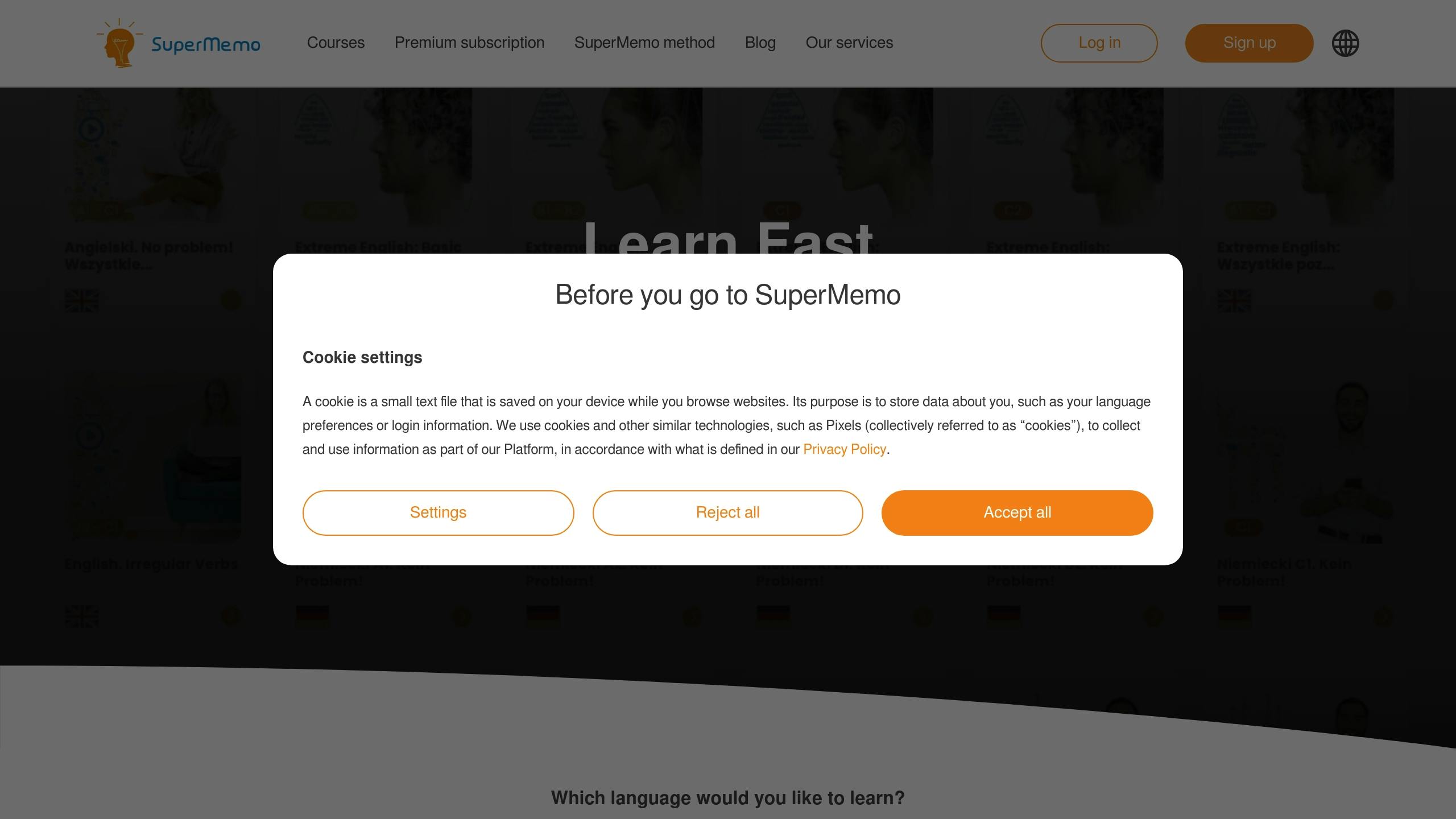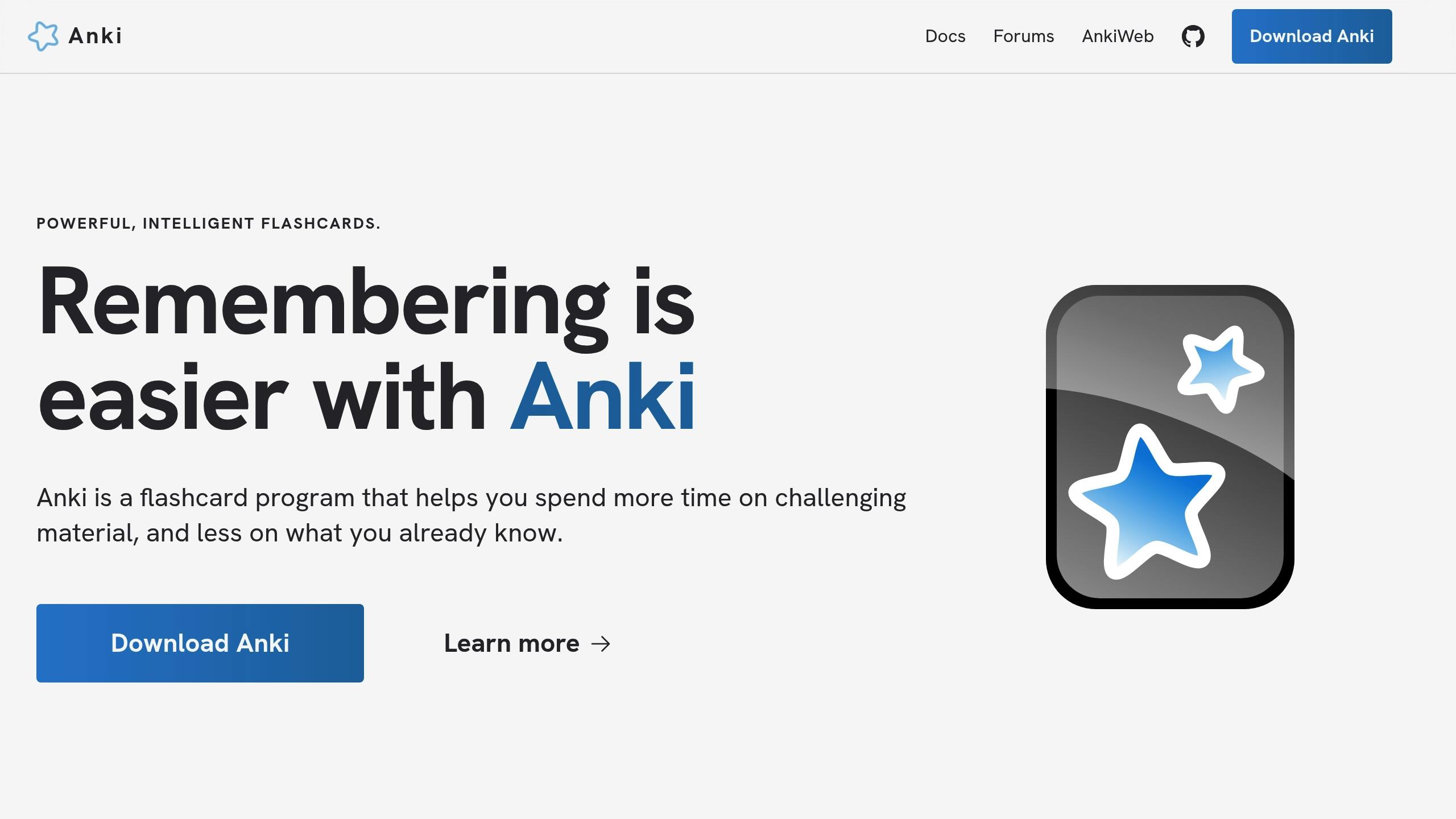
Top 5 Spaced Repetition Algorithms Compared
Spaced repetition helps you remember more by reviewing information at just the right intervals. This article compares the top 5 spaced repetition methods, so you can find the best one for your learning style:
- SM-2 (SuperMemo 2): A foundational algorithm using a 0-5 rating scale to calculate review intervals. Best for straightforward facts like vocabulary or dates.
- Anki: A flexible, open-source tool with customizable intervals, multimedia support, and a vast library of shared decks. Ideal for complex topics like languages or medical studies.
- Mnemosyne: Research-focused, offering detailed analytics to refine learning. Works well for academic study but lacks advanced multimedia features.
- Leitner System: A manual, physical flashcard system that organizes cards into boxes based on mastery. Great for tactile learners but requires more effort.
- QuizCat AI: AI-driven, it transforms your notes into quizzes, flashcards, and even podcasts. Adapts to your performance and is perfect for digital learners.
Comparing spaced repetition algorithms
Quick Comparison
| Algorithm | Ease of Use | Customization | Best For | Key Features |
|---|---|---|---|---|
| SM-2 | Moderate | Limited | Long-term academic study | Adjusts intervals based on performance |
| Anki | Easy | High | Medical and language learners | Multimedia support, shared decks, open-source |
| Mnemosyne | Easy | Moderate | Research and academic study | Analytics-driven, science-based approach |
| Leitner | Very Easy | Low | Tactile learners | Hands-on, offline, physical flashcard system |
| QuizCat AI | Very Easy | Very High | Digital learners | AI-powered, converts notes into quizzes and podcasts |
Choose the method that fits your study habits and goals. Whether you prefer hands-on tools or AI-driven solutions, there’s an option for everyone.
1. SM-2 (SuperMemo 2)

Developed in 1987 by Piotr Wozniak, the SM-2 algorithm was one of the first tools to bring spaced repetition into the public domain. It took a mathematical approach to improving memory retention, laying the groundwork for many systems used today.
The algorithm relies on a 0-5 recall rating scale:
- 0: No recall
- 1: Very poor
- 2: Poor
- 3: Moderate
- 4: Good
- 5: Perfect
Using these ratings, SM-2 calculates the next review interval based on your performance and an ease factor. This approach ensures that information is reviewed at just the right time to reinforce long-term memory. It also adjusts the difficulty dynamically, making it easier to retain information over time.
Key features of SM-2:
- Predictable review schedules
- Automatically adjusts difficulty based on past performance
- Accounts for the natural forgetting curve
While SM-2 is powerful for memorizing straightforward facts - like vocabulary, dates, or definitions - it does have its limits. It doesn’t consider the complexity of the material, the learning environment, or individual preferences. For more nuanced topics that require deeper understanding, SM-2 works best when paired with other learning strategies.
Next, let’s take a closer look at how Anki builds on this concept.
2. Anki

Launched in 2006 and based on the SM-2 algorithm, Anki is an open-source tool that takes spaced repetition to the next level. It’s designed to cater to a variety of learning needs, making it a go-to choice for many.
Key Features
- Review Rating System: Users can rate their recall as 'Again' (missed it), 'Hard', 'Good,' or 'Easy.' These ratings adjust future review intervals.
- Customizable Algorithm: Anki starts with shorter review intervals, gradually increasing them as you get better at recalling the material.
What Makes Anki Stand Out
- Fully customizable review schedules
- Handles rich media like images, audio, and videos
- Extensive library of add-ons for extra functionality
- Free to use and open-source
- Syncs effortlessly across devices
Drawbacks to Consider
- Has a steeper learning curve than simpler apps
- The interface may feel outdated to some users
- Mobile versions lack some desktop features
- Creating decks manually can take time
Anki is versatile, capable of managing both basic facts and intricate topics. Whether you're tackling a new language or studying for a professional exam, it offers unmatched flexibility. However, this flexibility comes with an upfront effort to set things up. Up next, we’ll dive into another tool with a different approach.
sbb-itb-1e479da
3. Mnemosyne

Mnemosyne takes a research-based approach to spaced repetition. This open-source tool uses a modified version of the SM-2 algorithm, focusing on gathering and analyzing user data to refine learning.
Key Features
- Research-Based Algorithm: Adjusts to your learning habits by analyzing recall accuracy and performance.
- Detailed Analytics: Offers in-depth stats, such as retention rates and review efficiency, to track your progress.
What Sets Mnemosyne Apart
Mnemosyne stands out for its dedication to cognitive science research. By collecting detailed data on your learning process, it uncovers patterns that other platforms often overlook. Its uncluttered interface keeps the focus squarely on studying.
The software works well with:
- Plain text cards
- Basic images
- Mathematical notation
- Simple audio files
Drawbacks to Keep in Mind
Despite its strengths, Mnemosyne has a few downsides:
- Limited support for multimedia compared to tools like Anki
- No built-in cloud sync feature
- Fewer options for customizing card templates
- Smaller user community, which means fewer shared resources
Performance Overview
| Aspect | Rating | Notes |
|---|---|---|
| Ease of Use | 4/5 | Quick and straightforward setup |
| Algorithm Effectiveness | 4.5/5 | Backed by research |
| Customization | 3/5 | Basic but functional |
| Cross-platform Support | 3.5/5 | Works on major platforms |
| Community Resources | 2.5/5 | Fewer resources than competitors |
Mnemosyne is a strong choice for students and researchers who value detailed learning analytics and a focus on scientific principles. Its simple design and straightforward features make it ideal for academic environments. However, users who need advanced multimedia options or highly customizable cards might find other tools more suitable. Next, we’ll look at a method that emphasizes a more manual review process.
4. Leitner System
The Leitner System is a practical, hands-on approach to spaced repetition. Unlike digital algorithms, it relies on physical flashcards and manual sorting based on how well you know the material. Let’s break down how it works and what makes it stand out.
Core Mechanics
This system organizes flashcards into 3-5 boxes, each representing a level of mastery. Here’s how it works:
- Correct answers: Move the card to the next box.
- Incorrect answers: Send the card back to Box 1.
- Higher boxes: Reviewed less often, reflecting stronger retention.
Box Review Schedule
| Box Number | Review Frequency | Confidence Level |
|---|---|---|
| Box 1 | Daily | New or challenging material |
| Box 2 | Every 2-3 days | Growing familiarity |
| Box 3 | Weekly | Solid understanding |
| Box 4 | Bi-weekly | High retention |
| Box 5 | Monthly | Mastered content |
Key Benefits
The Leitner System has several strengths:
- Hands-on learning: Physically sorting cards helps reinforce memory.
- Offline-friendly: No need for devices or internet.
- Customizable: Adjust the system to suit your learning pace and goals.
Limitations to Consider
However, there are a few downsides:
- Time-consuming: Requires regular upkeep and organization.
- Physical risks: Cards can be lost or damaged.
- No automatic tracking: You’ll need to manually monitor your progress.
Performance Overview
Here’s a quick summary of how the Leitner System stacks up:
| Aspect | Rating | Notes |
|---|---|---|
| Ease of Use | 3.5/5 | Simple concept, but manual effort is needed. |
| Effectiveness | 4/5 | Proven method for retention over time. |
| Customization | 4.5/5 | Easily tailored to individual learning needs. |
| Portability | 2.5/5 | Flashcards require physical storage. |
| Cost | 5/5 | Low-cost solution with minimal materials required. |
The Leitner System is a great option for tactile learners and those who prefer physical tools over digital apps. Its straightforward approach has influenced modern spaced repetition techniques, making it a reliable choice for mastering new material.
5. QuizCat AI

QuizCat AI takes spaced repetition to the next level by combining digital technology with personalization. It adjusts review intervals based on how you learn and the complexity of the material, thanks to its advanced AI.
How It Works
QuizCat AI's algorithm processes uploaded study materials to create tailored learning paths. It supports popular file formats like PDF, DOCX, and TXT, automatically turning your notes into study tools.
Key Features
| Feature | What It Does | Why It Helps |
|---|---|---|
| Smart Quiz Generation | Turns notes into targeted questions | Helps you focus on key concepts |
| Adaptive Flashcards | Changes review timing based on your progress | Boosts memory retention |
| Audio Learning | Converts notes into podcasts | Makes studying convenient anywhere |
These tools make studying more efficient and flexible.
Impressive Stats
QuizCat AI has earned the trust of over 400,000 students. So far, users have taken over 5 million quizzes, and the platform holds a stellar 4.8/5 satisfaction rating, backed by feedback from more than 530,000 users.
What Users Are Saying
The platform is designed with simplicity and accessibility in mind. One student shared:
"It was a lifesaver during finals - my notes quickly became quizzes and flashcards, like having a personal tutor 24/7."
Why It Stands Out
QuizCat AI shines by transforming notes into various learning formats. As Emily Carter put it:
"I was drowning in notes before I found this tool. Now, it turns everything into flashcards, quizzes, and even podcasts!"
The AI doesn't just stick to fixed intervals; it continuously adapts based on your performance, making your study sessions more effective than traditional methods.
Algorithm Comparison Chart
Here's a quick breakdown of various algorithms based on their usability, flexibility, and key features:
| Algorithm | Ease of Use | Customization | Ideal for | Key Features |
|---|---|---|---|---|
| SM-2 | Moderate | Limited | Long-term academic study | Research-supported framework for spaced repetition |
| Anki | Easy | High | Medical and language learners | Open-source, large shared deck library, supports diverse content types |
| Mnemosyne | Easy | Moderate | Research and academic study | Built-in stats and a science-focused interface |
| Leitner | Very Easy | Low | Beginners using physical flashcards | Simple tactile system without the need for tech |
| QuizCat AI | Very Easy | Very High | Digital learners | AI-driven, converts materials into quizzes, flashcards, and even podcasts |
While SM-2 and Leitner stick to proven traditional methods, tools like Anki, Mnemosyne, and QuizCat AI bring a modern touch with more flexibility and interactive features. Choose the one that aligns with your learning preferences.
Which Algorithm to Choose
Picking the right spaced repetition algorithm depends on your study goals and how you like to learn. Here’s a breakdown of the top options for different situations.
For intense exam prep or students with tight schedules, QuizCat AI is a strong choice. It transforms your study materials into quizzes and flashcards with ease. With over 400,000 active users and a 4.8/5 rating from more than 530,000 reviews, it’s a go-to tool for saving time. As Jake Harrison puts it:
"Literally a lifesaver during finals. Uploaded my notes, hit 'create,' and BOOM - quizzes and flashcards ready to go. It's like having a personal tutor 24/7."
Medical and language students often turn to Anki. Its vast library of shared decks and customizable features make it perfect for mastering technical terms or new languages. Plus, the active community provides plenty of ready-made resources. If you prefer something with a research-based foundation, SM-2 is worth considering.
The SM-2 algorithm is designed for long-term retention. While it takes a bit of effort to learn, it’s highly effective for subjects where deep understanding over time is key.
For new learners or those who enjoy a hands-on approach, the Leitner System is a great match. This method uses physical flashcards and doesn’t require any tech, making it simple and engaging.
Ultimately, the best algorithm is the one that aligns with your study habits and helps you stay consistent.
